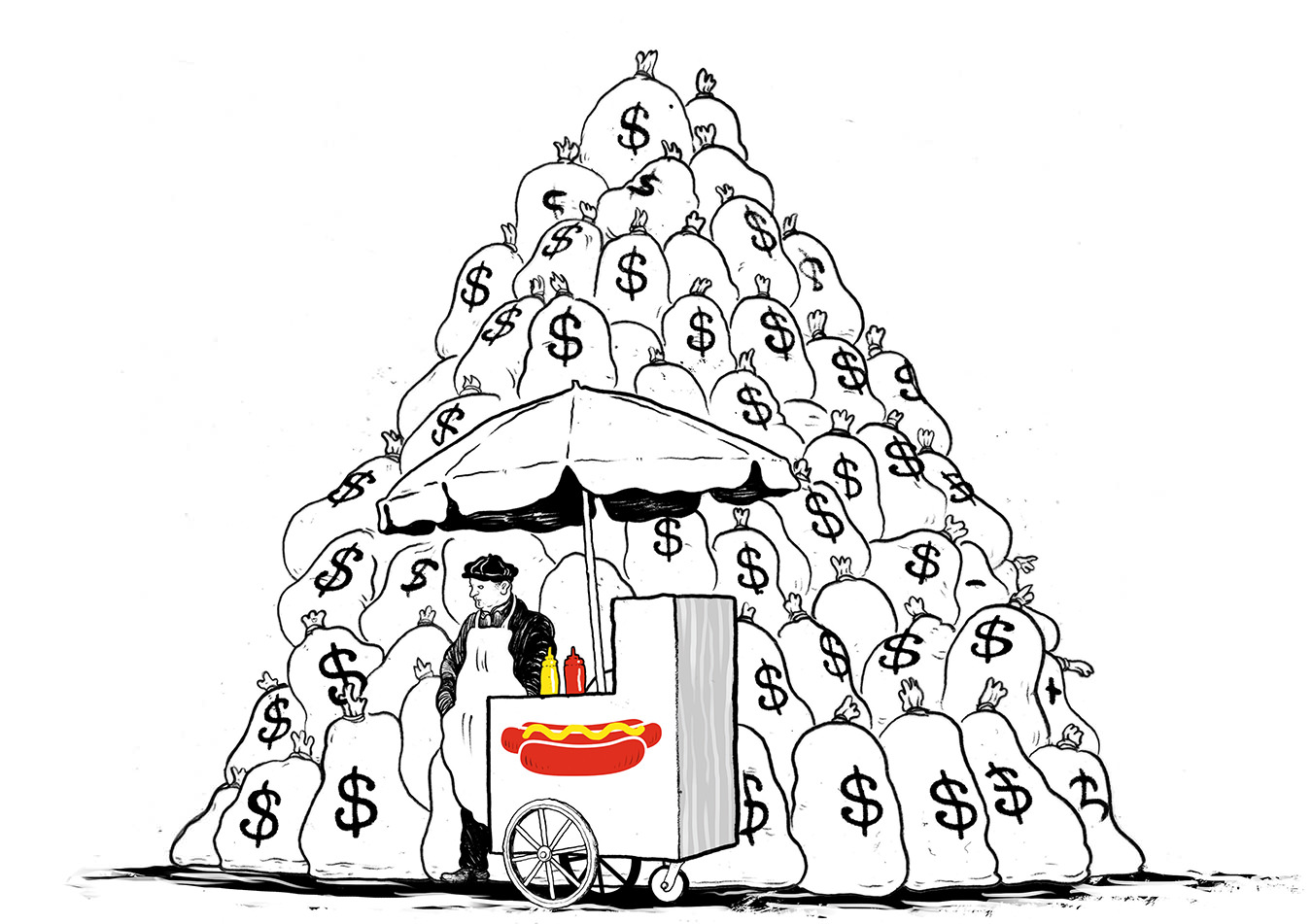Investing in Health Care
Are health care stocks the perfect cure for the sick portfolio?

Illustration by David Foldvari.
Death, taxes, and the lengths to which we will go to avoid either: three things of which we can be reasonably certain in this increasingly uncertain world. Such wisdom accounts for the ongoing popularity of, among other things, organized religion and offshore tax havens. It also goes a long way to explaining why health care may be the best investment idea of all time.
Stop me if you’ve heard this one before: We are getting older. Not just individually, but as a society. Average life expectancy in developed countries has been rising steadily over the past several decades; here in Canada, a child born today can now expect to live 81 years, up from 71 years 50 years ago. Worldwide, there are currently 810 million individuals over the age of 60, more than in any other time in history. By 2050, that number is expected to reach close to two billion.
While seniors may be less willing to shell out for video games, a new pair of kicks, or the latest magnum opus from Katy Perry, they are more than willing to ante up for prescription drugs, artificial joints, and the professional care that soothes our later years. Short of quitting your day job and becoming a doctor, a pharmacist, or a chiropractor, putting some of your money into one of the companies in the business of providing products and services to a rapidly-aging population could be the best financial move you’ll ever make.
If that’s not enough to get your financial curiosity piqued, consider this: traditionally, the heath care sector has been one of the best places to put your cash in times of stock market turmoil—the idea being that people will still reach for two Aspirin capsules when they have a headache, without checking what the economy is doing first. Such anecdotes are borne out by the numbers. Since October of 2007 (i.e., before the onset of the Great Recession), the S&P Developed-Nation Healthcare Index has returned an average 5.16 per cent a year. Compare that to the 1.24 per cent offered by the broad-market S&P 500 over the same time frame. When the rest of the market is falling apart, it seems that old drugstore on the corner is a pretty good place to put your life savings.
Of course, no investment is without risk. And over the past several years, there has been plenty of it in the health care sector. Pharmaceutical manufacturers have had to deal with the prospect of a number of blockbuster drugs coming off patent in the near future; whether new molecules will provide a replacement for those revenues remains to be seen. Medical device firms, traditionally some of the most reliable performers in the health care sector, have had product recalls and production problems. Insurance companies, hospitals, and other service providers have suffered through the ongoing political rancour surrounding the passing of “Obamacare” south of the border.
And so we come to the $64,000 question: Will a rapidly-aging population carry the healthcare industry to bigger and better things? Or will the issues experienced over the past few years keep the sector from reaching its full potential? Are health care stocks the perfect prescription for what ails your portfolio? Or are they simply one more example of the snake oil that Wall Street likes to sell?
The Final Frontier
Analyst David Shove has seen a lot of change in the health care industry over the past 20 years. Shove got his start in the industry with insurance, working as a consultant and then managing director at several large United States-based providers. He then made the switch to the financial side of the business, analyzing and evaluating the balance sheets of the companies he used to work for. He’s now a senior health care services analyst at BMO’s New York office.
From a big-picture perspective, Shove believes health care is the something of a “final frontier” when it comes to investment growth. “We’re all getting older, and so we’re going to use more health care,” he points out. “So to the degree that you’re looking for growth, there’s only a couple of places that offer organic growth. One is technology, and one is health care. And that’s really about it. Everything else is becoming more efficient and using less resources. Health care and technology are both about using more resources.”
Growth is all well and good, but as Shove points out, the nature of health care growth has started to change. “The trends are more holistic now,” Shove says. “There was a time that we were finding new drugs and new technologies that actually either extended life or sort of solved the health care problem—maybe a cure or a partial cure. But a lot of what we’ve learned through science is that a lot of our state of health is a lifestyle issue. So to the degree that a product or a service allows us a healthier lifestyle, it becomes of greater value and therefore more investible.”
Shove believes this reflects a larger societal shift in the way we view health. “Our definition of ‘being healthy’ is changing,” Shove notes. “It’s starting to focus more and more on quality of life and our abilities to be active.” As he explains, baby boomers are not content to simply live longer—they want to live better. And this desire creates a tremendous opportunity for any company that can help them remain, if not young in years, then perhaps young at heart. “The latest and greatest stuff in medical technology … [is] geared toward giving you more lifestyle choices. So you don’t have to be in the hospital so long; so you can go home earlier; so you can go back to work. Or maybe people don’t want to go back to work; they want to go back to skiing at Whistler.”
Despite all the hullabaloo about Obamacare, Shove doesn’t see the passage of the president’s contentious law as a negative for the health care industry. Sure, there will be winners and losers, but on the whole, the idea of bringing insurance to the uninsured is a good thing. “That probably is a positive for health care—at least for health care investing,” Shove says. “Because if you’re not paying for services, you have to give them away. And in America, when you give them away, you lose money. When you go from not having insurance to having insurance, and the hospital goes from getting no money to getting some money, that’s a positive thing.”
Take Two Stocks and Call Me in the Morning
For investors looking to put some of their hard-earned money to work, Shove believes health care is a pretty good place for it. But investors need to be discriminating. Although he acknowledges ETFs and mutual funds are certainly an option (particularly for investors with neither the time nor the inclination to do their own homework), Shove views the health care sector as a place where it pays to be picky. “I think more and more, it’s becoming a stock picker’s sector,” he says. “You’re probably better off trying to find the right stock.”
Instead of thinking of health care as a homogenous whole, Shove believes investors need to focus on those portions of the sector most able to benefit in the years to come. Example: managed care. Ever since Obamacare threatened to turn the health insurance industry into a government monopoly (never its intention), the stocks of those companies involved in the delivery or financing of health care services have been on life support. But Shove believes such concerns have been greatly overblown. “Companies like Aetna, and Cigna, UnitedHealth Group—these companies have shown themselves to be amazingly resilient regardless of government programmes and changes,” Shove says. “The stocks are fairly cheap right now—they’re trading at about eight times forward earnings—so this is one place you might think about.”
Shove also likes the home health care space. “This plays exactly to what we’re talking about,” he notes enthusiastically. “People don’t want to be in hospitals. They want to be at home. They want to be able to sort of live their lives and, still at the same time, receive medical care, so those kinds of companies are probably ideal right now.”
As for big pharma, Shove still believes in the science. But the stocks—that’s quite another question. “The pharmaceutical boom—the innovation in pharmaceuticals occurred almost twenty years ago. Since then, we haven’t had a lot of blockbuster drugs,” he says. “Biotech drugs and genetics are a whole different story. But it’s very, very hard to figure out which of those processes or drugs is going to be a success.”
If anything, big pharma currently reminds Shove of the utilities sector: reliable, steady earners operating in a mature industry and generally lacking a strong catalyst for growth. “They sort of have that profile: they’re something everybody needs—people need electricity; a lot of people literally need pills to stay alive—they throw off a lot of cash; they have a good, solid dividend that grows,” Shove notes. “But there isn’t a lot of organic growth. There’s not a lot of new customers. Maybe in emerging markets, but it’s been harder for the pharmaceutical companies to get in there because the doctor distribution [channel] is more fragmented and reimbursement is [an] unknown.”
As for health care as a defensive play, Shove is not so sure that the sector lives up to its billing anymore. “What’s happening in America is that we are—as with everything American—we are turning [health care] into a consumer product,” Shove muses. In these difficult times, instead of rushing out to buy more health care, consumers have been cutting back and making do with what’s on hand. “We’ve been using less health care, and it doesn’t appear that we’re that much sicker. So it probably goes to show that we were overusing it. And until that overutilization is all gone, it is not the ultimate defensive sector.”



